
27 minute read
NEW ATHLETIC FACILITY
The Johnson Memorial Health Athletics Annex at Franklin College is on the horizon thanks to a $1 million commitment from the Franklin-based health-care network.
The indoor multiple-use annex will be located on the College campus, at the southwest corner of Park Ave. and Second St. Retractable batting cages, golfing surfaces, a weight room and ample indoor spaces will accommodate a variety of athletic practices to support skills development and conditioning year-round. Nearly 44% of the student body participates in the College’s 21 men’s and women’s athletic programs.
“This generous gift is the latest endorsement of our wonderful working relationship with JMH,” said Franklin College President Kerry Prather. “We partnered with JMH on the creation of our Graduate Health Sciences Center, and again with the employment of our campus nurse. The hospital and its staff have been incredible partners in hosting undergraduate interns and graduate-level physician assistant studies majors for clinical experiences. Athletically, our student-athletes are extremely well-served by JMH, as the preferred provider of health-care services for our athletic department.”
JMH President and CEO David Dunkle ’94, M.D., said, “Our intent is to always provide greater access to resources students can use to maintain and improve their physical health. The Johnson Memorial Health Athletics Annex is an example of our ongoing commitment to be invested in the well-being of not just the Franklin College community, but the surrounding community as a whole.”
The College previously made athletic facility upgrades in 2011, when outdoor venues for tennis, softball and track and field were built in Grizzly Park, and Stewart “Red” Faught Stadium received turf and lights for football, soccer and lacrosse. J
Franklin College and Indiana Sports Corp. will host the 2026 NCAA Division III Swimming and Diving National Championships, scheduled at the IU Natatorium in downtown Indianapolis.
Franklin College previously hosted in 2012 and 2018. The 2026 event is projected to bring more than 500 student- athletes from around the country to compete in 40 events over a four-day period.
Hosts were announced in October 2020, but bidding for 86 of the 90 NCAA championships began in August 2019. More than 3,000 bid applications were received. Each sport committee, per division, selected the host sites it believed would provide the ultimate experience for the respective student-athletes, resulting in more than 450 championship sites selected. The four championships not included in the process due to preexisting arrangements were Division I baseball, football and softball, and Division III women’s ice hockey.
Indiana Sports Corp. leads the statewide initiative Team Indiana, whose mission is to promote the state as a premier destination for sports-related events. Team Indiana also has involvement with past, present and future NCAA Championships. J
Franklin College President Kerry Prather and JMH President and CEO David Dunkle ’94, M.D.
HOSTS OF CHAMPIONS


RETURN TO PLAY
With the start of spring semester also came an unusual practice and game schedule resulting from postponed seasons caused by the pandemic. In addition to the traditional spring competitors, the football, soccer, tennis and volleyball teams are recouping their seasons, in accordance with Heartland Collegiate Athletic Conference guidelines.
“Grizzlies always display grit through adversity, and the early-season wins posted in basket- ball, swimming and diving, track and field, and volleyball indicate this year will be no exception. We are very proud of our student-athletes, coaches and athletic training staff for their adaptability,” said Andrew Hendricks, director of athletics, and head swimming and diving coach.
“The coaching staffs are fully committed to helping student-athletes stay focused on academics, as we continue to work on synchronizing the limited practice areas, playing spaces and locker rooms, and navigate the unpredictable weather.”
Hendricks wants to remind fans that live coverage of most home games is shared free on the GRIZTV streaming service. At present, coverage includes Grizzlies’ football, soccer, volleyball, lacrosse, basketball, baseball and softball. Additional team coverage is in the works.
To access GRIZTV, start at the athletic website, FranklinGrizzlies.com. Next, look for the Fan Zone in the menu across the top of your computer screen and select GRIZTV, or scroll to the bottom of the page on your smart phone and click the GRIZTV logo. Then, you should see a schedule of upcoming broadcasts, plus archives of previous games. J
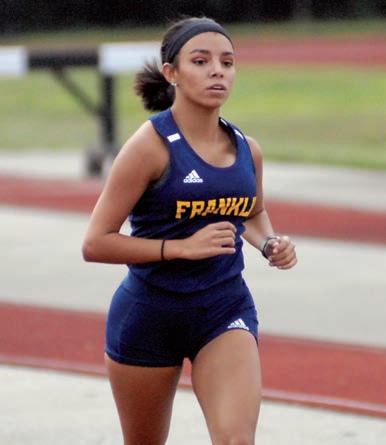

RUN ON THE
Angelina Gregory ’23 and Wyatt McCullough ’24 pace their respective teams.
PHOTOS BY RYAN THOMAS
The men’s and women’s cross-country teams had a memorable fall season in 2020.
To prioritize safety yet enable competition, the Heartland Collegiate Athletic Conference (HCAC) conducted a Virtual Racing Series. Teams competed inde- pendently at their respective campuses and recorded times that were reported to the HCAC and compiled to reveal the winners and leaders.
The first race in September was a 3200-meter run at Grizzly Park. Franklin’s men placed second in the eight-team field with 84 points, while the women took fifth place with 116 points. Four additional races followed, with the season closing in November.
big heart FOR GOOD CAUSE
The fifth annual Big Heart 5K run/walk founded by the Franklin College football team in memory of former player Wes Shambaugh ’15 was held in November 2020. Shambaugh died from an enlarged heart, at age 23, in March 2015.

Over the years, supporters of the fundraiser have enabled the College to purchase eight automated external defibrillators and install them in facilities across campus. The portable devices can help those experiencing sudden cardiac arrest by analyzing the heart’s rhythm and, if necessary, delivering an electrical shock, to help re-establish an effective rhythm.
Due to the pandemic, the official 2020 event was virtual, but several participants showed up to “Walk for Wes” in person at Meadowood Park in Speedway, Indiana, where his mother resides. Pictured are Jeremy Parker ’15, Joey Pasquale ’15, Jonny Hession ’15, Joe Rush ’14, Jonny West ’14 and Kyle Linville ’13. J
In the final event, a 6K, the women’s team racked up 106.5 points to take fifth-place overall Two women cracked the top-15, Angelina Gregory ’23 and Taylor Wooten ’22. Gregory earned sixth-place overall and set a new personal best of 24:52.0, and Wooten placed 12th while setting a new personal best of 25:24.0.
Other runners included Jill Anspaugh ’23, Bessie Kerr ’24, Grace Esterline ’21 and Josie Lyons ’24.
In their final race, an 8K, the men collected third-place overall with 87 points. Matching the women’s team, the men had two runners make the top-15, Wyatt McCullough ’24 and Chris Graham ’20. For the fourth time in five races, McCullough paced the field. He finished ninth overall, with a time of 26:20.0. In 14th place was Chris Graham ’20, who clocked in with a time of 26:50.0.
In his inaugural 8K, Jack Sells ’24 earned 20th-place overall with a time of 27:22.0. Jaycee Wilburn ’23 and Parker Mullins ’24, who claimed identical times of 27:52.0, shared 29th place. Other participants included Drew Hargis ’24, Jordan Johnson ’22, Eli Cochrane ’24, Henry Davidson ’22, Ethan Bequeret ’23, Matthew Lee ’22, Brayden Devenport ’24 and Steve Bellamy ’24.
Watch video-recorded interviews with the runners and get more cross-country news at Franklin- Grizzlies.com. J
SUPPORTING STUDENT-ATHLETES
For the second consecutive year, Niel Ellerbrook and his spouse, Karen, made a generous gift to the athletic department to provide charter bus transportation for coaches and student-athletes. Their support helps ensure safe and comfortable travel for Grizzlies competing away from home.
“We thank the Ellerbrooks for their philanthropic hearts and generosity,” said Director of Athletics Andrew Hendricks, also the head swimming and diving coach.
“Athletics play a major part in shaping lives, and thanks to the Ellerbrooks we can offer students even greater life-changing experiences that build confidence, lead to success and create lasting memories.” J
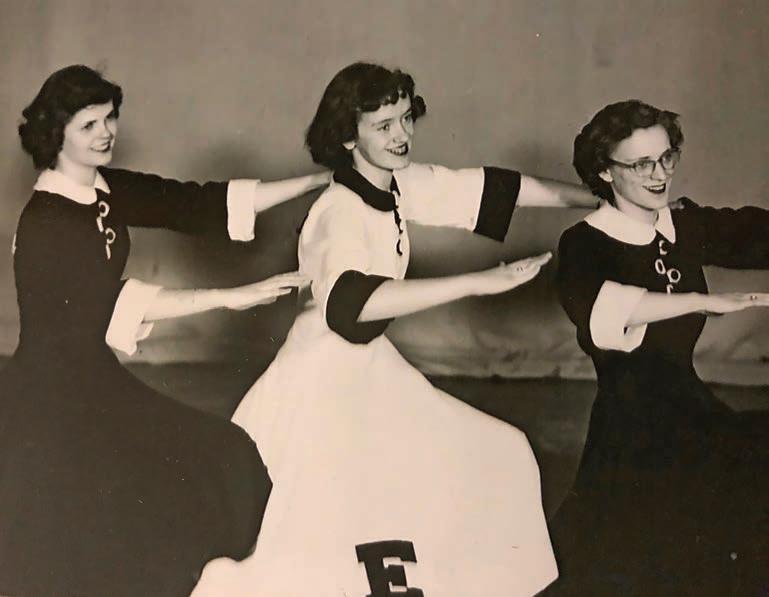
TIMELESS TALE
It tells the story of Joe Lain ’57 and spouse Marilyn (Wertz) ’57, and it’s an Indiana story. Listen closely. Can you hear the ball bouncing in that shoebox they called a gym?
Big time
Tell me, I’m saying to Joe, about the loss to Batesville.
Silence. We’re talking by speaker phone, Joe and Marilyn at their home in Edinburgh. They’re 85 years old, and no, they’ve never left, and after a second or two of silence I’m wondering if we’ve lost the connection.
“Sigh.”
What was that?
“Well,” Joe says, “you were asking about Batesville.”
On the morning of the 1951 Sweet 16, Edinburg had one starter taking penicillin to fight a cold, and another starter looking for a whirlpool to work out the kinks in his neck. Like the deck wasn’t already stacked against the Maroons, you know? The team eventually gets on a bus that winds through Franklin, where people are lining the streets to cheer a 200-car procession, led by the mayor and police chief, heading to Hinkle.
The Edinburg cheerleaders, a squad of three girls, are taken onto the court at Hinkle and shown where their fans will be sitting later, then led through a maze of corridors to the basement, where they are given a room to practice. It’s all too much for the girls who made their cheerleading outfits with the longest skirts in Johnson County, then decided to trim the fabric a few inches above the knee. The principal caught wind of that, called them into
The Edinburg cheerleaders, with Marilyn (Wertz) Lain ’57 at middle.
By Gregg Doyel, The Indianapolis Star (Reprinted with permission.)
The scrapbook tells the story of love, war and basketball. Family photos and newspaper clippings of people who aren’t around anymore, of a time that no longer exists, from a town that changed its name along the way but stayed true to itself.
There’s a picture of the dog that disrupted the 1951 Indiana high school basketball tournament, and the cheerleading skirts that might’ve done the same if given a chance. There’s a picture of a tall girl and shorter boy, and a picture of a tall man and shorter woman, photos of the same people taken 75 years apart. There’s a picture of the big city — Franklin, population 7,500 — sending the boys of Edinburg on to Hinkle Fieldhouse in Indianapolis.
The scrapbook tells the story of families brought together and broken apart, of farms lost and love found. It tells the story of Pearl Harbor and World War II and a couple who met in second grade and are still married decades later.
his office and told them to reattach the fabric, or they wouldn’t cheer for the Maroons.
That was traumatic enough, but now they’re being led through the cavernous Fieldhouse, sure they’ll get lost and never be heard from again.
“We were scared to death,” recalls Marilyn, then a sophomore. “It was the most awesome and upsetting time. It was such a huge place, and when we got onto the floor we couldn’t find our crowd. They were all spread out.”
While the cheerleaders stared into a faceless mass of 15,000, the Edinburg players were traumatized as well. Forward Gene Harrell had that cold, and forward Curt Calvert ’59 — a member of the Greensburg All- Regional team — had that stiff neck, and Batesville had all that size, and pretty soon the score was 15–2.
But Edinburg hadn’t made it this far by giving up.
World affairs, local impact
Let’s rewind a bit. Remind you of the events in Pearl Harbor, and what that meant more than 4,000 miles away in Edinburg. And, let’s get to the spelling. Yes, the town is spelled Edinburgh, but it’s gone back and forth over the years — named after Edinburgh, Scotland, in the early 1800s but shortened to Edinburg in 1899. The “h” was restored in 1977.
On Dec. 7, 1941, Edinburg was minding its own business, same as all those soldiers at Pearl Harbor, when the Japanese bombed the naval station. The U.S. government already had purchased more than 40,000 acres for a military training center in Central Indiana, land that included 15 cemeteries, five schools and the town of Kansas, but the attack accelerated the timeline of the military training base they named Camp Atterbury.

“All my relatives on both sides were residents of the area, and they all had to go different directions. Everybody had to get out,” Joe explains. That included his grandfather, Ed Neville, who lost 300 acres.
“My Grandpa Neville never did get over the fact he lost his farm,” Joe says.
It also was a time of sacrifice for Marilyn’s family, who had a two-bedroom home in Edinburg. They took in a displaced Camp Atterbury couple, renting them a bedroom and sharing the house’s one bathroom, and made do. Marilyn and her sister (now Phyllis (Wertz) Huckabone ’54) slept on a pullout couch, their twin brothers in cribs in their parents’ bedroom. The boys slept in those cribs until World War II ended; they were 6.
“My dad was superintendent of Amos Thompson woodworking,” Marilyn
A loose dog interrupts the Sweet 16.
MARILYN (WERTZ) LAIN ’57
says. “He was frugal, and he could make a buck.”
Joe’s parents had lost their 80-acre farm to Camp Atterbury and moved four miles east to Edinburg, finding work at Cummins Engine Co., making parts for U.S. tanks. Joe started second grade at the oneroom schoolhouse in Edinburg, where he noticed the tallest girl in class, Marilyn. He blew it right out of the gates, stuffing a Valentine’s Day card into the class box with her name on it, but misspelled as Marilyn Works, not Wertz. The teacher figured it out, but Marilyn was not amused.
“I let him know that wasn’t right,” she says, and I can hear Joe giggling.
Joe fancied himself an athlete, but he couldn’t outrun Marilyn in the school races at recess. Nobody could, not until sixth grade, when Joe finally beat her.
“I thought, ‘Boy, that’s going to make her mad!’” Joe says. “But she came over and shook my hand, big smile on her face, and said: ‘Congratulations.’ From about that point, I thought, ‘This is going to be my girlfriend.’ But she was always taller than I was until after eighth grade, when I finally had a growth spurt. That’s when she said, ‘OK, this could be my boyfriend.’”
Now I can hear Marilyn giggling. In December, they will celebrate their 64th anniversary. (Since the article’s original publishing date, the couple have celebrated their milestone.)
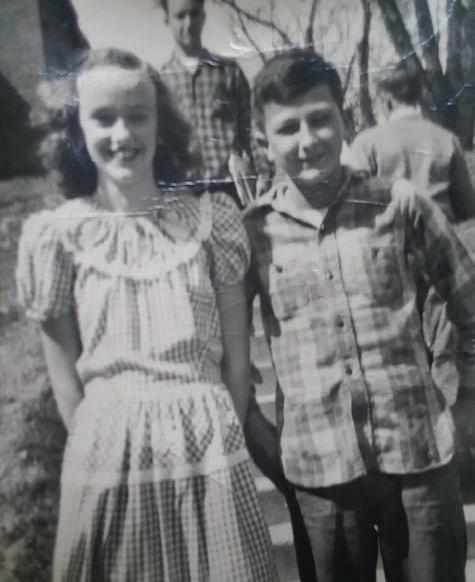
JOE LAIN ’57
You’ve heard about the love and war. Let’s get back to the basketball. And the dog.
Doggone Sweet 16
Behind one basket of that gym at Edinburg High, the stage was out of bounds. Behind the other? A wall. On the sides, a 6-foot wall was the boundary, with the bleachers above it.
“We were playing in a little box,” Joe says.
Makes the story even better, and this story — that team in 1951 — seemed destined to make history. They’d just hired a new coach, Harold Hickman ’49. He was 25, taking over a program that had never won regional, hadn’t won sectional in 40 years, and with an enrollment of 138 kids didn’t seem likely to change that in 1951. The Maroons started the season 1–3, but rallied behind five senior starters — 5’11” sophomore Joe was the sixth man — to finish the regular season 12–6.
For the school’s first Sweet 16, Edinburg pretty much shut down on March 10, 1951. That included the town’s after- noon newspaper, which published early that day so the entire staff could get to Hinkle. In those days, Edinburg was the country’s smallest town with a Boys Club, and billed itself as the “Veneer Center of the U.S.,” thanks to the Amos Lumber and Veneer Co. When the town needed a doctor, it organized the Edinburg Civic Corp. to raise money and attract one.
To get ready for that gigantic court at Hinkle, Hickman took his players to the gym at his alma mater, Franklin College.
“Kind of nice,” Joe remembers. “Got out of school early, went up to Franklin to practice. But when we went to Butler, after playing in these small gyms, oh my gosh, that basket and backboard looked so small I was almost afraid to shoot it.”
Edinburg started slow, trailing Batesville 15–2, as Marilyn and the two
other cheerleaders tried to encourage a cheering section they couldn’t see.
“To this day,” Joe says, “I don’t know whether that was stage fright or what. I know Curt (Calvert) wasn’t feeling good. But we did get within about three or four points at the start of the fourth quarter. But then the Butler Bulldog came out on the floor.”
Hang on, I’m telling Joe. Butler’s mascot in a costume walked onto the court?
“A real living dog!” he’s saying, and I’m making a note to visit The Indianapolis Star archives later, because there’s just no way . . .
I’ll be darned. The newspaper on March 11, 1951, has a picture of the dog, and the details. It’s a boxer, not a bulldog, owned by Municipal Court Judge Joseph J. Howard. What’s a judge doing bringing his dog to the Sweet 16? Great question. But the dog is on the court, near the foul line, as the referee approaches with a smile and two Edinburg players glare in the background. Because they know: They’d had the momentum.
And sure enough, the momentum is gone. After the stoppage, Edinburg’s run is over in the game, and the tournament. The final score, Batesville 45, Edinburg 37. Joe scored five points that day.
“I didn’t know how that dog got loose on the floor,” Joe says, 69 years later. “I still don’t know.”
The picture of the dog is in the scrapbook, whose red cardboard cover is scratched and stained, but lined with the purest gold trim. The book has survived seven decades and looks ready for seven more, and thank goodness for that. People don’t last forever, but the story of Edinburg’s 1951 regional champion — a story of love, war and basketball — is timeless. J
. . . AND STILL TODAY
The Lains were elementary school sweethearts, who continued their courtship in high school and at Franklin College. He was in Sigma Alpha Epsilon fraternity and played on the basketball team for two years, as well as served as junior and senior class treasurer. She was in Delta Zeta sorority and fondly remembers sisterhood activities, including building floats for Homecoming parades. They married in December of their senior year.
The Lains built lifelong friendships with Franklin classmates, and have attended several Homecoming reunions during the years since their graduation. Today, they also enjoy rooting for the Grizzlies at home basketball and football games.
“It’s one of the things we miss getting to do when we spend the winters in Florida,” Joe said. He is retired from State Farm Insurance, and she is retired from teaching fourth grade at Edinburgh’s Eastside Elementary.
The Lains have made a series of generous financial gifts to the College over their lifetimes, earning distinction as Heritage Society members. The couple have taken advantage of a matching program from Joe’s former employer to help maximize the impact of their gifts.
“State Farm’s matching gifts have been a really good way for us to help the College,” said Joe.
For them, College support is an investment in the community.
“What Franklin College does is not only important for students, but for the whole of Johnson County,” Joe said. “We believe the community needs the College, and the College needs the community.” J
PHOTO BY MARLA RAMSEY
Joe Lain ’57 and spouse Marilyn (Wertz) ’57
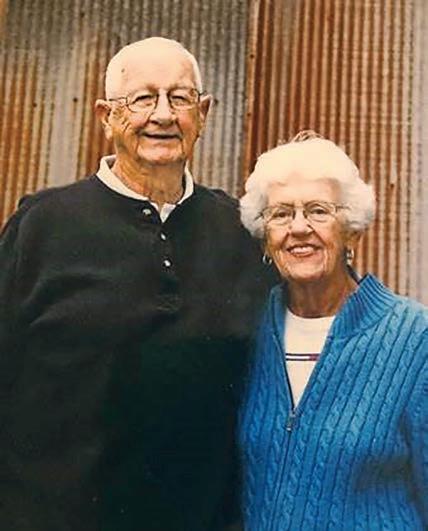
Your Franklin Fund gifts matter.
Armani Christopher ’23, exercise science major Serves as a resident assistant, involved in Black Student Union, Intervarsity, Student Athlete Advisory Committee and football.

“As a sociology major, I was encouraged to take a wide variety of classes. This semester I enrolled in Color and Design. What I thought would be a stress-reliever turned into so much more. Through this course, I learned more about my goals, my values and myself as a person. It also increased my confidence and helped shape me. It is a difficult course, but the professor inspires and motivates me.”
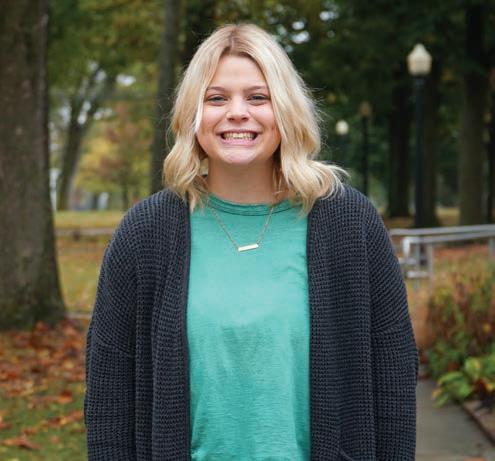
Ava Mayer ’24, sociology major Employed in a work-study program.
FRANKLIN FUND GIFTS
● Help students who need scholarships and other financial assistance during the ongoing pandemic. ● Advance the innovation, leadership and action students and graduates are demonstrating around the world. ● Demonstrate confidence in the College’s reputation and value.
SKY’S NOT THE LIMIT
By Alexa Shrake ’23, Pulliam Fellow
Carley Campbell ’16 is in the habit of aiming high in all she does, regardless of breaking with convention. From creating an individualized college major to joining the historically male-dominated U.S. Air Force, Campbell has taken risks to reach her goals.
Campbell came to college with a passion for government and foreign affairs, but the traditional academic majors weren’t an exact fit for the future she imagined.
“The idea of graduating and moving into a typical 9 to 5 desk job was my personal nightmare and, quite frankly, still is. I wanted a career that would challenge me,” Campbell said.
Guided by her interests and aspirations, Campbell collaborated with associate professors of political science Allison Fetter-Harrott, Ph.D., J.D., and Randall Smith, Ph.D., to develop an individualized major in global security and international relations.
“They really went above and beyond to help me find internships and build the major I wanted; they made a lasting impact on me,” Campbell said. “My Franklin College Model U.N. experience also played a huge factor in my career decision-making.”
The Air Force, with its mission “to fly, fight and win in air, space and cyberspace” has presented Campbell with the career challenges she hoped, and then some. Like all recruits, Campbell went through eight weeks of Basic Military Training to build up physical and mental skills.
“I will admit, it blind sided me to look around the room and see that I was maybe one of two women in a room full of airmen, but that feeling subsided over time. In my experience, everyone looked out for each other and worked as a team.”
According to a May 2020 Brookings Institution report, across the four major U.S. Department of Defense services, women represent only one of every six Americans in uniform, and about 19% of the Air Force. In 2020, the Air Force appointed a woman for the first time to the senior enlisted role of Chief Master Sergeant, with JoAnne S. Bass making history.
Campbell also made military news last year. She was specially selected for Airman Leadership School and earned the coveted John Levitow Award. Recipients must rank in the top 1% of their class and excel in communication and collaboration throughout the 24-day program.
“It’s an honor to be making these steps for those before us, and of course, all of those who will follow us in the future,” Campbell said.
Recently, Campbell graduated from the Defense Language Institute Foreign Language Center (DLIFLC) in California. The center trains specially selected military personnel to become linguists, regionally-focused consultants with war-fighting competencies as well as cross-cultural language and communication skills critical to U.S. efforts in multinational environments. The DLIFLC assigns the language that must be learned. Campbell received Russian.
“I was quite nervous having to learn it in about 18 months. The grammar for Russian is particularly intense, and becoming fluent that quickly was an experience,” she said.
Next on Campbell’s horizon is a transition to the Air Force Reserves, which will allow her to stay in the military and join the workforce; a return to active duty also remains on the table. For now, she lives on the Fort Meade military base in Maryland with her spouse, Colby Martin. They met at the DLIFLC. She also is launching an online graphic design business and drafting a novel. J
SUBMITTED PHOTOS
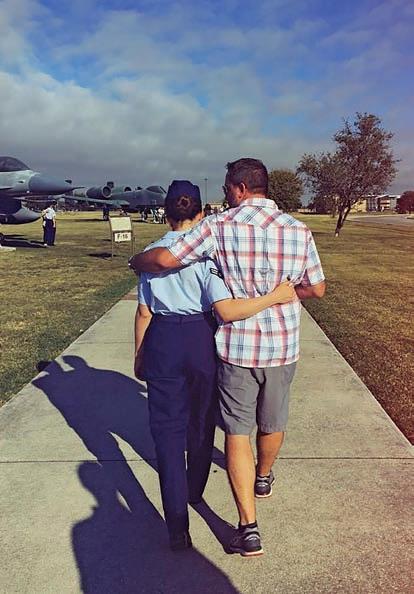
Carley Campbell ’16 walks with her father across base.
SPREADING GOOD VIBES
By Alexa Shrake ’23, Pulliam Fellow

Meet Macey Dickerson ’15, full-time artist, eternal optimist, nature enthusiast and podcast fan. Here, Dickerson shares a glimpse of her recent works, the artistic process and the positive messages she’s channeling through her creative impulses.
GBD IMAGES
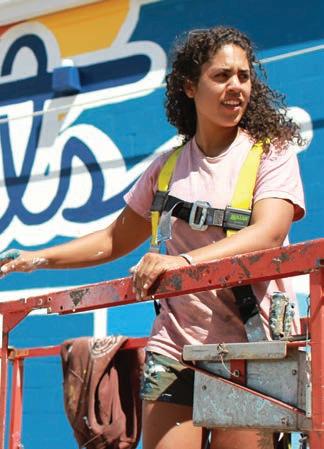
GBD IMAGES What is the significance of the mural you did for Wessels Co.? “Wessels (worldwide manufacturer of water tanks for HVAC systems) was looking for a colorful mural with minimalist design to revitalize a wall, 108 feet by 20 feet, at their headquarters in Greenwood (Indiana). I worked with the marketing team to create a unique and timeless design that incorporated water motifs and some of their most popular products.
“I also recently painted a mural for Natura Wellness, a store on Water Street in Franklin (Indiana). This was a fun project because Kelly Doerr, the owner, gave me free rein on the design. After meeting Kelly and getting a sense of the space, have undergone a personal realization, I feel compelled to express it visually. I find a lot of meaning in taking a new found internal truth and externalizing it.
“My aim with VibeHigh (herb-infused jewelry) is to create wearable pieces of art that help people to be intentional about their mood and mindset. I do this by using resin to inlay herbs and flowers in laser-cut wood. The herbs that I incorporate are ones that I have chosen for their symbolic meaning (rose for love, lavender for peace, mustard seed for faith, etc.). I think of these pieces as a visual reminder to bring peaceful loving energy to every moment of the day. By being intentional about our own
I painted a tree, 12 feet tall, with chakra centers on its trunk encircled by glowing orbs.
“I enjoyed how collaborative these projects were. It’s an honor to help a client transform their space so that it reflects their unique vision.”
What sparked your interest in art? “I have enjoyed creating art since I was a child. I showed some talent from a young age and was privileged to refine my skill by enrolling in after-school art programs and taking lessons at local art centers as I grew up.”
What is your intent as an artist? “I use paintings as a way to punctuate a period of inner transformation. After I
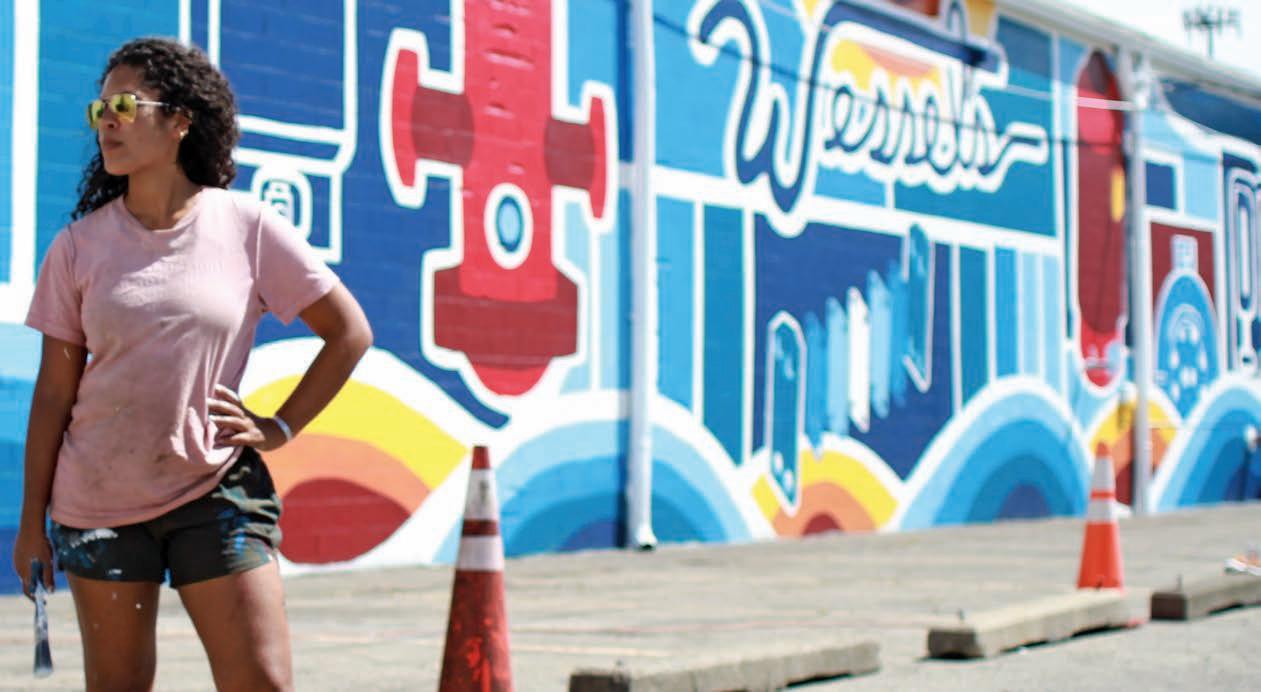

attitudes, we participate in manifesting a more kind and beautiful world.
“In both jewelry and painting, I like to explore mystical themes using an organic aesthetic. I’m in love with finding the divine in the ordinary and trying to reveal the intangible through the tangible.”
How did Franklin College help prepare you for a career as an artist? “I majored in fine arts with a minor in psychology. Fine arts classes were very important to helping refine my artistic skills. David Cunningham (associate professor of art) set high expectations that pushed me out of my comfort zone and helped me develop the self-discipline needed to create art for a living. Dr. Svetlana Rakic’s (professor of art) course, The Spiritual in Art, was foundational for my spiritual growth, which fuels and sustains my creative impulse.”
What is your favorite form of artistic expression? “The main mediums I work in are digital design, canvas art, murals and jewelry. Each has its unique challenges, and it’s hard to pick a favorite!”
What artwork has been the most inspirational for you? “I have been really inspired by all of the public artwork since George Floyd’s murder (killed May 25, 2020, during an arrest for allegedly using a counterfeit bill). Artists have the opportunity and the obligation to contribute our talents for the greater good. It is so heartening to see creatives get involved and activated. All of these new murals across the country demonstrate the power of art to reflect and inspire social change.”
What are your hobbies/ interests? “One of my biggest hobbies is listening to podcasts and audiobooks while creating art. I also enjoy spending time in nature.” J Find Macey Dickerson Arts on Etsy. She’s offering alumni and friends a 10% discount on VibeHigh jewelry in her Etsy store. Use the code GRIZGRAD at checkout.
Visualizing UNITY

TAYLOR DRANE ’13

STACIE (TANKSLEY) DRANE ’13
STACIE (TANKSLEY) DRANE ’13
By Alexa Shrake ’23, Pulliam Fellow
Stacie (Tanksley) Drane ’13 prefers using a paintbrush rather than a microphone to amplify her voice. Drane’s contest-winning outdoor mural speaks volumes about her love for the local community, gratitude for diversity and hope for the future.
Her 2020 design impressed judges in charge of the Johnson County Community Foundation’s Color the County mural program last summer. Since 2016, the program has brought together local artists and residents through a collaborative process of making murals, transforming public spaces and expressing neighborhood identities. The program has funded 10 murals countywide. While Drane designed the winning mural, the public was invited to help paint it on a wall at Taxman Brewing Co.’s gastropub in Bargersville, Indiana, last August.
What is the meaning of the mural in Bargersville? “I really wanted it to emphasize unity. The parent and child images just below the dove symbolize compassion and love, and their hands reaching for each other represent inclusivity, with all of humankind wanting to feel united. The sun shining on their faces, while setting and rising, represents the hope of a new day. The farming silos and city lights represent harmony between the agricultural and industrial areas of Bargersville, and also symbolize the small community’s unity with the surrounding larger towns. All the plants are symbols of hope, rebirth and growth. I wanted to show that even in the darkest of times we can find light.”
What sparked your interest in art? I think art has always been my escape. For some people, it’s books and writing, for me it’s always been painting and drawing. I graduated from college with degrees in painting, design and art history.” What is your intent as an artist? “I always want viewers to be moved and inspired, and to feel that they can relate the art to their own life.”
How do you hope your artwork impacts the community? “The community of Johnson County is so diverse. I wanted to be able to represent everyone who lives here, from the small towns to the bigger cities. I hope the mural brings light and color to our community, especially during this time of uncertainty, I want the community to feel united as we look to the future. It’s also very important to me for my daughters, Haley, 2, and Alaina 10 months, to know their mom had a voice in the community, even though I’m not the most outspoken person. I want them to know and feel unity and inclusion as they grow up.”
How did Franklin College help prepare you as an artist? “I would say Art History with Dr. Svetlana Rakic (professor of art) really helped me understand how significantly the arts influenced society during different time periods. Since then, Cubism, Futurism and Abstract Art have fascinated me, and they influenced my mural design. My college classes also are where I refined the technical design skills I used working in the field prior to staying home with my children.”
What are your hobbies/interests? “As a stay-at-home mom with two daughters, my days tend to be filled with lots of Goldfish® crackers, juice boxes and snuggles. When I do get free time, I enjoy photography and traveling.” J

